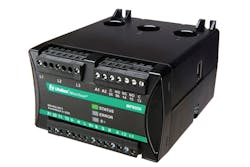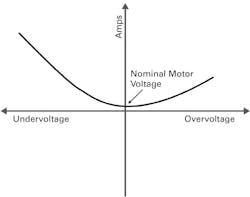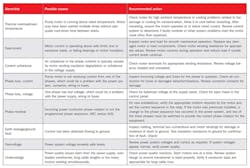More and more pump motors are protected with smart motor protection relays. These microprocessor-based units promise to greatly speed up troubleshooting and minimize downtime. Motor protection relays can detect problems with pump motors, pumps, wiring, controls or power systems. Not only will they prevent damage to the pumping equipment, but they will also provide clear indication about the nature of the problem. These relays may display the information on a built-in screen or provide this fault information to the repair technician via the Internet of Things, a local network or even a wireless connection to a smartphone. But what do the different fault codes mean? And knowing what an error code means, what should the technician do to resolve the problem?
This article will explain what a smart motor protection relay measures and what its different outputs and alarms mean in the context of actual equipment.
Jam
A jam is essentially the ultimate overload — Effectively, something has stopped the motor from turning, and it will quickly overheat and be damaged if it is not immediately disconnected from power. The motor protection relay will quickly trip to prevent these damaging conditions. The relay must also be intelligent enough to know when the motor starts normally to temporarily disable the jam protection. Larger motors can take several seconds to accelerate, and these conditions must be clearly distinguished from a jam condition.
Thermal overload
Thermal overload represents the physical overheating of the motor. This can be detected by temperature sensors embedded in the motor windings. These sensors are typically positive temperature coefficient thermistors or resistance temperature detectors. These devices make direct thermal measurements of the motor and provide additional protection that cannot be determined from electrical measurements alone. Problems that can be detected by thermal sensors include high ambient temperatures, loss of motor cooling caused by damaged fans or debris, or starting the motor too frequently. In addition, these sensors allow motors to be monitored to allow adequate cooling periods before restarting after normal operating or faults.
Overcurrent “overload”
Overcurrent is a condition in which the current flowing to a motor exceeds its maximum safe amperage. Overload relays are required for safe operation of three-phase motors. They follow inverse trip curves (i.e. Class 5, Class 10, etc.) that will trip quickly if a motor current is dramatically above safe operating limits, or can allow minutes of operation if currents are slightly above limits. A motor protection relay can use these currents to estimate a motor’s thermal operation. It represents this by calculating a motor’s thermal capacity. A cold motor that has not been operating has 100 percent thermal capacity; A motor that just tripped due to overcurrent conditions has zero percent thermal capacity.
The thermal capacity calculations are intended to create trip conditions before the motor actually reaches unsafe temperatures. This is because of lag in temperature rise from the motor’s thermal mass. Overcurrent conditions can be caused by problematic conditions including loads in excess of the motor design, failed bearings, debris in pumps that create impeller drag including “locked rotor” or high/low voltage.
Undercurrent/underload
Undercurrent/underload represents a condition in which the current or power consumed by the motor is less than expected. While a load that is lower than expected may not harm the motor, in most conditions it is important to disable equipment operating with unintended underload. Obvious problems that cause this condition are the failure of a drive coupling or belts between the motor and the pump. Another less obvious condition that can be detected by the relay is the loss or reduction in pump flow. If the pump intake was partially or totally restricted, or a valve was improperly closed in the discharge side of the pump, the reduced flows can be detected by a drop in current/power to the motor.
Some specialty pumps exhibit only a small change in motor current caused by a loss of intake fluid, but with that comes a much larger change in power factor for this condition. A smart motor protection relay can be set up to detect the change in power caused by the load loss.
Another example is a submersible pump that will normally run dry from time to time. Careful adjustment of the underload restart delay on the motor control relay can allow time for a well to recover and return to normal operation without having to shut everything down or restart the system.
Figure 1. Operating a motor at higher or lower than normal voltage will increase current draw, potentially shortening the life of the motor.
Overvoltage
A motor is designed to operate at a single voltage, as shown in Figure 1. Voltage in excess of the motor’s rated voltage can increase current draw, leading to overheating and shortened motor life. Starting torque and current will be greater than normal, which may cause problems with associated mechanical equipment. Once running, however, pump operation will potentially trip on overcurrent or create unnecessary heating that will shorten the motor’s life.
Undervoltage
Undervoltage has many effects on a motor. Starting a motor with voltage below the rated voltage will decrease starting current and starting torque, potentially increasing the time to reach normal operating speed. Full-load current, however, increases as voltage falls, which can lead to overheating and shortened motor life. A poorly regulated primary power system can cause periodic undervoltages and overvoltages.
Voltage/current unbalance
If one phase that supplies a motor has less voltage than the other two (often caused by poorly distributed single-phase loads on the same power system), one or more of the motor windings will see excessive current and overheat, degrading the winding insulation and shortening the motor’s life. The amount of unbalance a motor can tolerate depends on the particular motor and how heavily it is loaded. A protective relay can be set up to ignore small unbalances and trip on larger ones. Correction may require redistributing single-phase loads.
Phase loss (missing phase)
Loss of power to one phase of a three-phase motor is typically described as “single-phasing.” This condition causes excessive overcurrent in the remaining motor windings and requires immediate action to prevent motor damage. Storm damage to power conductors is a primary source of single-phase conditions. Other sources of phase loss include an opened fuse, damaged contact in a contactor or a loose conductor termination.
Phase reversal
Most three-phase equipment is intended to rotate in one direction. Pumps are good examples. An impeller that rotates in the wrong direction will do no useful work and may damage the equipment if left in this condition. The direction of the motor rotation is related to the phase rotation of the power system. This rotation can be changed simply by switching the order of two of the three power conductors connected to the equipment. Motor protection relays provide reverse phase protection aid in the proper installation of the equipment and also detect and protect motors if a change occurs in the power system. This can occur in the replacement of a transformer or other wiring upstream of the motor control cabinet.
Table 1. Pump troubleshooting causes and actions
Ground fault
A direct short to ground is an obvious fault and will cause a fuse or circuit-breaker to operate immediately. A low-level ground fault is a different condition. It requires a protective device capable of detecting lower level currents and tripping the equipment offline before a more serious condition occurs. When current begins to flow to ground at low levels, perhaps because of degraded motor insulation, contamination or moisture, the current is often insufficient to open a fuse or breaker. If left undetected, this low-level ground current will continue to increase and eventually severely damage the motor. A motor protection relay can be programmed to detect such a low-level fault current and trip out, preventing extensive damage. The correction may be as simple as shutting off power and drying the motor, or it may require a more expensive solution including taking the motor out for rewinding.
Some electrical systems use high-resistance grounding, which will limit a fault current if one phase is directly shorted to ground. This allows systems to “alarm” and continue to operate until a scheduled service time is determined by the operators.
Summary
A modern motor protection relay can prevent damage from a variety of problems. It is the technician’s job to be familiar with the meanings of the relay’s various error codes to know how to identify a problem and what steps to take to correct it.
Kip Larson is director of product technology, Electrical Business Unit, Protection Relays for Littelfuse. He has more than 20 years of industrial electronics product design and application experience.






